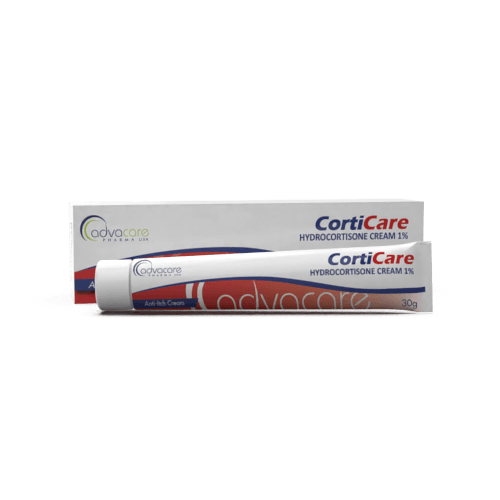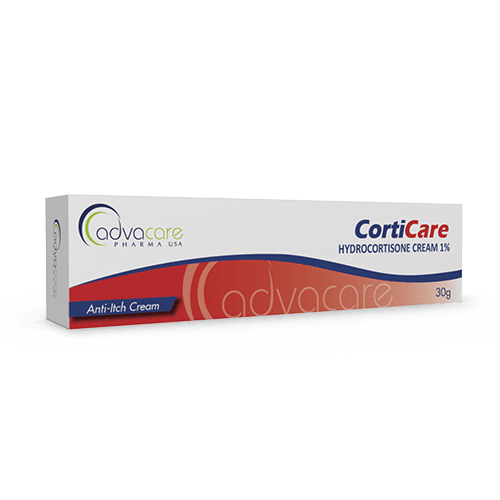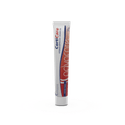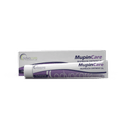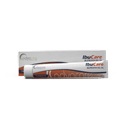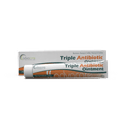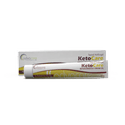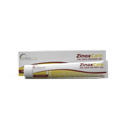- Home›
- Pharmaceuticals›
- Topicals›
- Medical Ointments›
- Hydrocortisone Cream
Hydrocortisone Cream
Form
Dosage
Packaging
What is Hydrocortisone?
Active Ingredients: Hydrocortisone
Hydrocortisone Cream is a topical steroidal drug used to treat skin inflammation, itching, swelling, irritation, and redness. It is used for the treatment of various conditions like insect bites, poison ivy, eczema, psoriasis, dermatitis, allergies, rash, and anal or outer female genital itching.
Hydrocortisone belongs to the family of medicines called corticosteroids. It works by preventing the release of chemicals that produce immune or allergic responses.
Hydrocortisone is also available as a lotion, ointment, or eye ointment. The eye ointment formulation is intended to treat inflammatory conditions of the eyes, such as those caused by conditions such as allergic conjunctivitis or nonpurulent conjunctivitis. Hydrocortisone Cream is intended for topical application only.
AdvaCare Pharma is a GMP-certified manufacturer and exporter of Hydrocortisone Cream. Our medical supplies are produced in facilities in China, India, and the USA. These facilities are routinely audited to ensure they comply with health, safety, and environmental standards.
Why are we a top Hydrocortisone Cream manufacturer?
AdvaCare Pharma is a US pharmaceutical company that manufactures Hydrocortisone Cream, and our entire range of 50+ topical treatments in cream, ointment and gel dosage forms, under stringent GMP regulations. Our distinctive approach to business fosters a highly collaborative relationship with our pharmaceutical distributors. For the past 20 years we have established a reputation as a trusted Hydrocortisone manufacturer, one of the 500+ pharmaceutical products in our comprehensive range, across more than 65 global markets.
Uses
What is Hydrocortisone used for?
It is used to treat inflammation and itching associated with skin conditions that are responsive to steroids. It is commonly used to treat conditions like allergies, insect bites, eczema, and psoriasis.
Can Hydrocortisone Cream be used on sunburns?
Hydrocortisone Cream can be an effective treatment for sunburns. The 1% cream can be applied to mild to moderate sunburns in order to reduce redness, itching, and swelling. Before applying, it may be helpful to cool the cream in a refrigerator for a short period of time. The cream can be applied up to 3 times per day, for 2-3 days.
How is Hydrocortisone Cream used?
This medication is manufactured as a sterile cream, which is intended for topical administration directly to the skin. It is not advised to use Hydrocortisone Cream over a large area of skin unless directed by a doctor. This product is intended to be only applied topically and should should not be ingested.
Always wash hands with soap and water before and after using this medication. When using the lotion or the spray formulations, the bottle should be shaken well just before use.
After application, the afflicted area should be left uncovered. Do not wrap, bandage, or cover unless otherwise directed by a healthcare professional. Covering the area can increase the absorption of the medication. It is not advised to use tight-fitting or plastic diapers on children being treated in the diaper area.
Can Hydrocortisone Cream be used on broken skin?
Do not apply Hydrocortisone Cream to severely broken skin, such as wounds or burns, unless directed by a healthcare professional. Using Hydrocortisone Cream on damaged skin could increase the risk of an infection.
How should Hydrocortisone Cream be stored?
When not in use, the bottle should be kept closed tightly and stored in a dry location at room temperature. Do not freeze this product.
What dose should be applied?
Adult Dosing Dosage may vary based on different medical indications:
- For steroid-responsive dermatoses, a small amount of cream should be applied to the afflicted area 2-4 times a day.
- For eczema, a small amount of cream should be applied to the afflicted area 2-4 times a day.
- For psoriasis, a small amount of cream should be applied to the afflicted area 2-4 times a day. Occlusive dressings can be used to manage psoriasis. If an infection occurs, the dressing should be discontinued.
- For the temporary relief of external anal itching due to proctitis, a small amount of cream should be applied to the afflicted area 3-4 times a day.
- For the temporary relief of external anal itching due to hemorrhoids, a small amount of cream should be applied to the afflicted area 3-4 times a day.
- For the temporary relief of external anal itching due to ulcerative colitis, a small amount of cream should be applied to the afflicted area 3-4 times a day.
- For the temporary relief of itching due to minor irritations or rashes (pruritus), a small amount of cream should be applied to the afflicted area 3-4 times a day.
Pediatric Dosing Recommended dosage for children may vary based on different medical conditions:
- For eczema, a small amount of cream should be applied to the afflicted area 2-4 times a day.
- For psoriasis, a small amount of cream should be applied to the afflicted area 2-4 times a day. Occlusive dressings can be used to manage psoriasis. If an infection occurs, the dressing should be discontinued.
- For the temporary relief of external anal itching due to proctitis, a small amount of cream should be applied to the afflicted area 3-4 times a day.
- For the temporary relief of external anal itching due to hemorrhoids, a small amount of cream should be applied to the afflicted area 3-4 times a day.
- For the temporary relief of external anal itching due to ulcerative colitis, a small amount of cream should be applied to the afflicted area 3-4 times a day.
- For the temporary relief of itching due to minor irritations or rashes (pruritus), a small amount of cream should be applied to the afflicted area 3-4 times a day.
- For mild to moderate cases of atopic dermatitis, a small amount of cream should be applied to the afflicted area twice per day.
Do not use in children younger than 3 months old. Do not use the cream with any occlusive dressings. Do not use for in the diaper area unless directed by a healthcare professional.
Refer to a doctor or healthcare professional for the exact dosage and duration of treatment.
Who can use Hydrocortisone?
Hydrocortisone Cream can be used for adults and children, but caution is advised for specific groups of patients.
Pregnant Hydrocortisone Cream should only be used if the benefits outweigh the risks for pregnant women. It is not recommended to use topical steroids for extended periods of time or in large amounts. Animal studies suggest teratogenic effects after the dermal application of more potent corticosteroids.
Breastfeeding Hydrocortisone Cream is not recommended for use by women who are breastfeeding unless there is a clear need for a topical steroid treatment. Hydrocortisone is known to be excreted in milk, though it is unlikely that dangerous amounts would reach the infant and there are not adequate studies on the effects on the infant. The lowest potency should be used, particularly on the breast. The cream should be thoroughly removed before breastfeeding.
Children Lower dosages of topical hydrocortisone are generally considered safe for pediatric patients over 2 years old. It is advised to keep the duration of treatment to a minimum (1 to 2 weeks). It is important to note that pediatric patients may absorb larger amounts of this medication, which may lead to systemic toxicity or other adverse effects, such as Cushing’s syndrome. Long-term or continual treatment with corticosteroids has been associated with problems with growth and development.
Geriatric Topical hydrocortisone is considered safe for use in elderly populations, however careful selection of the steroid and dosage is recommended. Geriatric patients may be more susceptible to adverse effects as larger amounts of the medication may be absorbed. The lowest effective dose should be used.
Other warnings
It is important to note that the systemic absorption of topical steroids has been associated with adverse effects such as reversible hypothalamic-pituitary-adrenal (HPA) axis suppression, Cushing’s syndrome, hyperglycemia, and glucosuria. The risk is increased when an occlusive dressing is used, during prolonged use, when used over a large area of the body, or when using high dosages of the medicine. In high-risk patients, it is recommended to regularly check urinary-free cortisol and ACTH stimulation.
Side Effects
As with all pharmaceuticals, some unwanted effects can occur from the use of Hydrocortisone Cream.
Common side effects include, but may not be limited to:
- mild skin irritation burning, or stinging
- acne
- skin color changes
- small bumps on the skin
Serious side effects may include:
- signs of an allergic reaction
- severe rash
- signs of a skin infection at the site of application
For a comprehensive understanding of all potential side effects, consult a medical professional.
If any symptoms persist or worsen, or you notice any other symptoms, please call your doctor.
Precautions
Do NOT use Hydrocortisone Cream if:
- You are allergic to Hydrocortisone or any other ingredient.
- You are allergic to other corticosteroids, like prednisone.
Skin infections may worsen while being treated with Hydrocortisone Cream.
There is little evidence concerning the use of Hydrocortisone Cream during pregnancy or breastfeeding, so consult a doctor or healthcare professional before treatment.
Do not ingest this product. It is intended for use only on the skin.
References
A randomized, double-blind trial on the use of 1% hydrocortisone cream for the prevention of acute radiation dermatitis
The main objective of this study was to determine whether the application of 1% hydrocortisone cream during radiation therapy can prevent the occurrence of moist desquamation.
This trial included 50 adult female breast carcinoma patients who were randomized after modified radical mastectomy and chemotherapy to receive prophylactic placebo cream (27 patients) or 1% hydrocortisone cream (23 patients) during radiation therapy. The patients, caregivers, and assessors were unaware of the treatment until the end of the study. During the trial, weekly evaluation was performed to determine the occurrence of moist desquamation, severity of acute radiation dermatitis (ARD), and hyperpigmentation.
Each group had 5 patients that developed moist desquamation, but its extent and severity were milder in the steroid group. The steroid group had lower mean ARD scores compared to the non-steroid group (0.713 vs. 0.874, p = 0.024). A reduced occurrence of Grades 1 and 2 radiation dermatitis was observed in the steroid group at weeks 2 and 4, respectively.
The conclusion of this study is that prophylactic steroid use delayed the onset of radiodermatitis.
Antipruritic and Thermal Sensation Effects of Hydrocortisone Creams in Human Skin
The main objective of this research was to evaluate the antipruritic effects of hydrocortisone (1% and 2.5%) on histamine-induced itch and sensory responses by assessing itch intensity, itch duration, and thermal thresholds using a computerized thermal sensory analyzer (TSA).
This was a double-blind, randomized, comparative, controlled, single-dose, single-center study in which histamine-induced itch was induced in both forearms by intracutaneous injection in 18 patients. Test sites on both forearms were treated with hydrocortisone 1%, 2.5%, and placebo. The following parameters were measured: thermal thresholds for warmth sensation, cold sensation, cold and heat pain using TSA. Itch intensity was assessed every minute for 10 minutes after histamine injection using a visual analogue scale (VAS), and itch duration was recorded. Compared to placebo, 2.5% hydrocortisone significantly (p = 0.03) reduced itch duration from 12.6 ± 11.0 minutes (mean ± SD) to 8.6 ± 8.2 minutes (a reduction rate of 32%), as well as itch intensity (at minutes 3, 6, 7, and overall). Placebo, 1%, and 2.5% hydrocortisone significantly altered (p < 0.05) the cold sensation threshold.
The conclusion of this study is that topical application of 2.5% hydrocortisone may be beneficial for treating histamine-induced itch.
You might be interested in...
Why AdvaCare Pharma?
As an industry leader, we are aware of our responsibility to provide affordable and sustainable solutions to improve healthcare worldwide.
